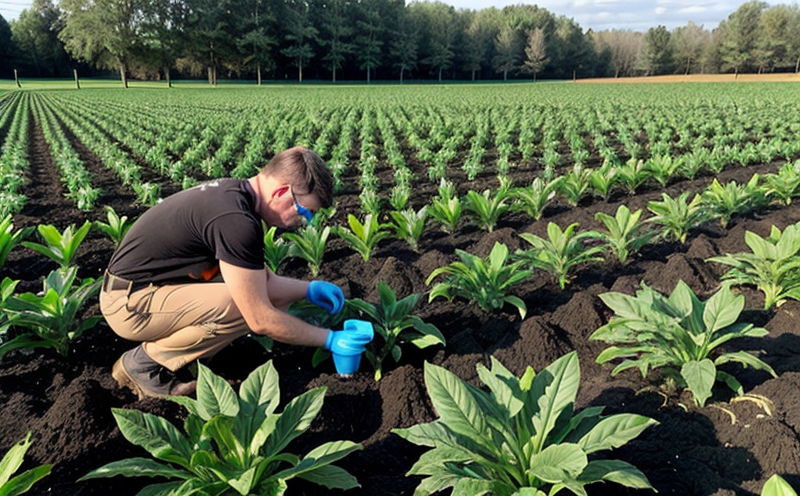Molybdenum Content Testing in Fertilizers
The accurate determination of molybdenum content in fertilizers is critical to ensuring that plants receive adequate nutrients, which can significantly impact crop yield and quality. Molybdenum plays a crucial role in various plant enzymes responsible for nitrogen metabolism, chlorophyll synthesis, and the utilization of other essential minerals like iron.
In agricultural applications, molybdenum deficiency is common in soils that are acidic or have high levels of calcium, magnesium, or phosphorus. This can lead to stunted growth, yellowing leaves, and reduced fruit production. Therefore, testing for molybdenum content ensures optimal nutrient balance and supports sustainable farming practices.
The typical method used for determining molybdenum in fertilizers involves digestion of the sample followed by a colorimetric or spectrophotometric determination using a reagent like vanadomolybdate. This technique is based on the formation of an intense blue-violet complex which can be quantified through absorbance measurements.
For quality managers and compliance officers, ensuring that molybdenum content meets specifications is essential for maintaining product integrity and meeting regulatory requirements. R&D engineers often rely on this testing to refine formulations and enhance performance. Properly conducted tests provide reliable data that helps in optimizing the nutrient delivery system within fertilizers.
When selecting a laboratory for such testing, it's important to consider factors like experience with similar analyses, proficiency in using specific equipment, and adherence to relevant standards. A reputable lab should be capable of handling various types of samples including granular and liquid fertilizers, ensuring accurate results regardless of the form or type.
The accuracy of molybdenum content testing is paramount; any discrepancies could lead to over- or under-application which may have detrimental effects on soil health and crop productivity. Thus, choosing a laboratory that adheres strictly to international standards like ISO 17025 for proficiency in analytical services can provide peace of mind.
In summary, accurate molybdenum content testing ensures optimal nutrient application leading to healthier plants and higher yields. By partnering with experienced laboratories equipped with state-of-the-art technology, stakeholders can ensure compliance with industry standards while also driving innovation in fertilizer formulation.
Applied Standards
| Standard | Description |
|---|---|
| ISO 17025 | Absence of bias and consistency in analytical methods. |
| ASTM D4834 | Determination of molybdenum in fertilizers by colorimetric method. |
| EN ISO 17025 | Requirements for the competence of testing and calibration laboratories. |
| IEC 61964 | Guidelines for quality assurance in laboratory operations. |
The above standards ensure that all tests conducted are precise, reproducible, and reliable. Compliance with these standards guarantees that the results obtained from molybdenum content testing are valid and can be trusted by industry professionals.
Industry Applications
In agriculture, accurate molybdenum content testing is vital for formulating balanced fertilizers. Farmers rely on this information to prevent deficiencies that could hinder plant growth and reduce yields. For instance, when applying nitrogen-based fertilizers, ensuring there's an appropriate amount of molybdenum helps in maximizing the efficiency of nitrogen uptake by plants.
Moreover, molybdenum testing plays a key role in precision agriculture where every aspect of crop management is optimized for maximum output and minimal waste. By using accurate data on fertilizer composition, farmers can tailor their application rates to suit specific soil conditions and climatic factors, thereby enhancing resource use efficiency.
In the context of environmental sustainability, proper molybdenum content testing supports efforts towards reducing unnecessary chemical inputs into ecosystems. This not only protects natural resources but also contributes positively to global initiatives aimed at minimizing pollution from agricultural runoff.
Use Cases and Application Examples
Agricultural researchers often use molybdenum content testing during field trials to assess the effectiveness of new fertilizer formulations. By comparing test results with established benchmarks, they can identify improvements needed in terms of nutrient ratios or addenda.
For quality control departments within manufacturing plants producing fertilizers, regular testing ensures that products consistently meet set standards and customer expectations. This helps maintain brand reputation and trust among consumers who value transparency and reliability when purchasing agricultural inputs.
In environmental monitoring programs focused on soil health assessment, periodic molybdenum content tests help track changes over time due to different farming practices or climate variations. Such data is invaluable for developing strategies aimed at preserving long-term productivity without compromising ecological balance.





